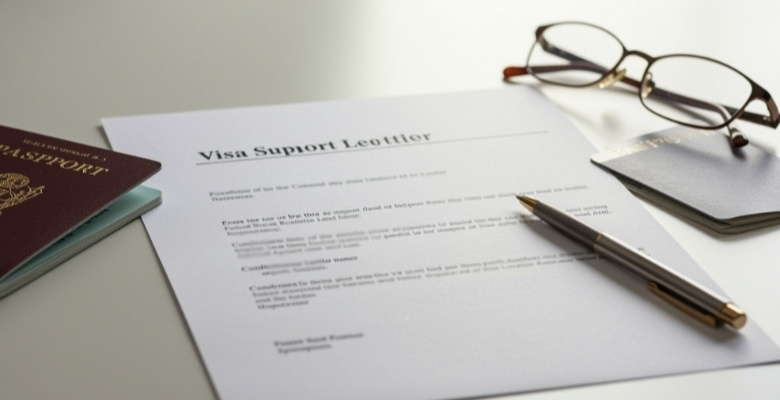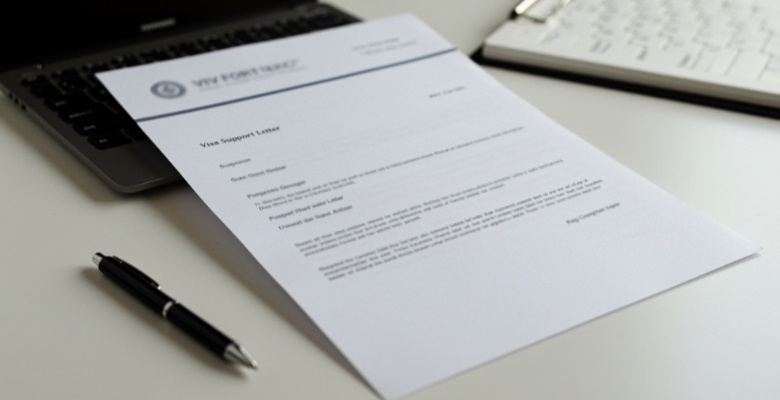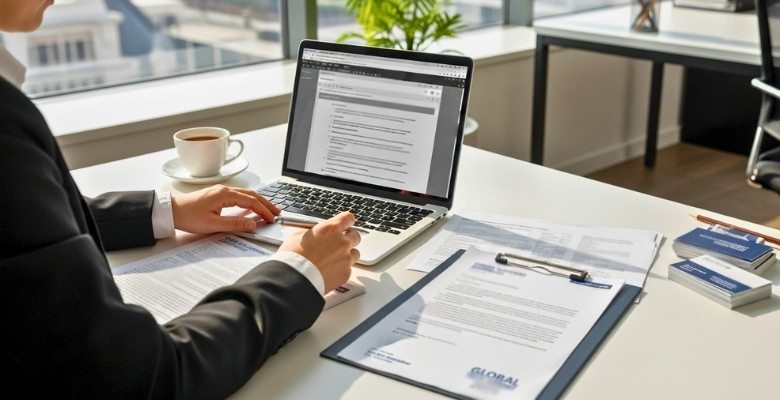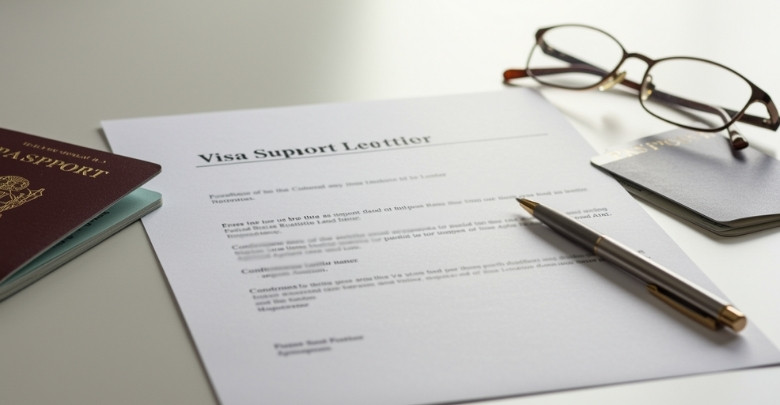A visa support letter can make a big difference in helping a guest secure their visa. As the host, this letter shows that you are officially inviting the visitor and taking responsibility for their trip. Many people often wonder what to include, how to write it, and what steps to follow. That’s why they often think about how do I write a visa support letter?
Write a visa support letter by starting with your full name, title, and address on official letterhead. Clearly identify the visitor with their full name, date of birth, nationality, and passport number. Explain the reason for the visit, add the travel dates and planned activities, and confirm who will cover expenses. End the letter with your contact information, a polite closing, and your signature.
If you’re thinking about writing one, this article will help guide you step by step. You will find all the key parts you need to include, the right tone to use, and common mistakes to avoid. Keep reading, and you’ll feel more confident about preparing this important letter.
How Do I Write a Visa Support Letter?
Writing a visa support letter means providing clear and reliable information that immigration officers can trust. As the host, your role is to confirm the visitor’s purpose, schedule, and support during their stay. Here’s how to structure the letter step by step:
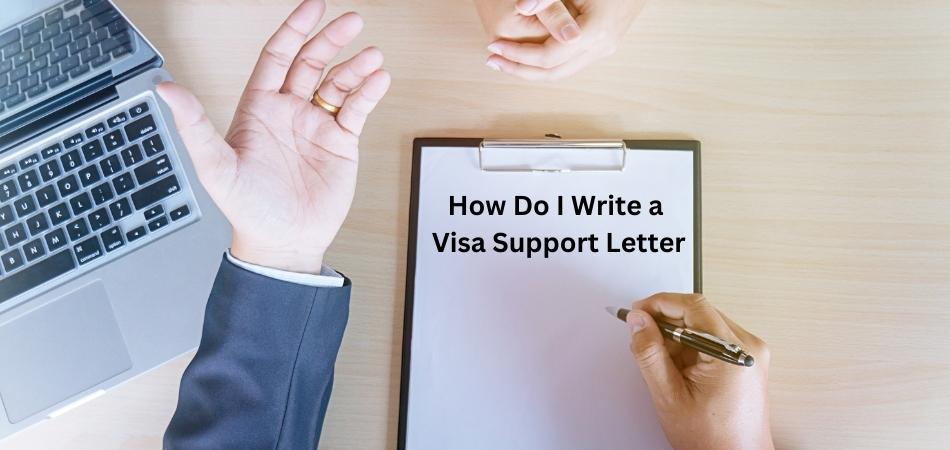
Step 1: Use Official Letterhead and Date
Always prepare the letter on your organization’s official letterhead or, if you are hosting privately, on a professional template that clearly shows your address. Include your full address, phone number, and email at the top. Place the current date under the letterhead, as embassies expect properly formatted and verifiable documents.
Step 2: Address the Embassy or Consulate Properly
Direct the letter to the correct embassy or consulate where the visitor will submit their visa application. If the officer’s name is unknown, use a polite and formal salutation such as “Dear Sir/Madam.” Properly addressing the consulate signals respect, professionalism, and ensures the letter appears valid for official purposes.
Step 3: Introduce Yourself Clearly
Identify yourself with your full name, your official job title, and your role in the host organization. If the invitation is coming from an institution, clearly state the organization’s name as well. This introduction establishes your authority to issue the invitation and demonstrates your accountability for supporting the guest’s travel.
Step 4: Identify the Visitor
Provide the visitor’s complete name exactly as it appears in their passport. Include their date of birth, nationality, and passport number. Immigration officers compare these details with the visa application, so accuracy is critical. Any inconsistencies can cause unnecessary delays or even rejection of the application, making precision an absolute priority.
Step 5: Explain the Purpose of the Visit
Describe why the visitor is traveling and what role they will play during the trip. For example, specify the invitation for a visit to the international conference where they will attend as a delegate, speaker, or participant. Highlighting this purpose reassures officials that the travel has a clear and temporary objective.
Step 6: Provide Travel Dates and Itinerary
List the expected arrival and departure dates along with a brief summary of activities during the visit. If the trip includes conferences, business meetings, or cultural programs, mention them in a simple outline. A structured itinerary gives consular officers confidence that the visit is well-planned and limited to the stated timeframe.
Step 7: Confirm Accommodation
Clarify where the visitor will stay during the trip and who will cover the expenses. If the host organization is covering accommodation, meals, or travel, make this clear. If the visitor is self-funded, confirm it. Transparency about financial responsibility prevents doubts about affordability and reassures officials that the traveler is fully supported.
Step 8: Offer Assurance of Return
Include a statement confirming that the visitor will return to their home country after completing the planned trip. While you cannot guarantee their actions, providing this assurance in writing strengthens the case that the travel is temporary. Immigration officers expect this reassurance to prevent concerns about overstaying.
Step 9: Close Formally
End the letter with a respectful closing, your full name, job title, and contact information. Sign the letter in ink and, if available, add your organization’s stamp or seal. This final step validates the invitation, making it official and more credible to the embassy or consulate reviewing the application.
Types of Visa Support Letter
A visa support letter changes depending on the purpose of travel. Immigration officers expect certain details to match the type of visa being requested. Below are five common types, explained in detail with ready-to-use templates for each:
Business Visa Support Letter
When a company or organization invites someone to visit for official business purposes, visa support letters for business travelers ease the visa processing task. The letter should clearly describe the reason for the visit, such as project discussions, negotiations, training sessions, or audits. It must also clarify the financial arrangements and confirm that the visitor will return home after completing business activities. Embassies review these letters carefully to ensure the trip is limited, professional, and temporary.
Here’s a sample:
[Company Name]
[Company Address]
[Phone, Email]
[Date]To: [Embassy/Consulate Name]
Dear Sir/Madam,
I, [Full Name], [Job Title] at [Company Name], hereby invite [Visitor’s Full Name], holding passport number [Passport Number], nationality [Nationality], to travel to [City, Country] from [Start Date] to [End Date] for business purposes.
The purpose of this trip is to [state reason: attend meetings, training, or contract discussions]. Accommodation will be arranged at [Hotel Name], and expenses will be covered by [Company/Visitor].
We confirm that [Visitor’s Full Name] will return to [Home Country] after completing the visit. Supporting documents, such as the meeting agenda, are enclosed.
Sincerely,
[Name & Title]
[Signature]
[Company Seal]
Short-Term Visit Visa Support Letter
When inviting a guest to visit or participate in an academic or professional event, this letter of support for tourist visa explains the purpose. It verifies the event’s name, location, and dates, and explains the applicant’s role as a delegate, speaker, or guest. Embassies often ask for this type of letter as proof of genuine participation in a short-term event.
Here’s a sample:
[Organization Name]
[Full Address]
[Phone, Email]
[Date]To: [Embassy/Consulate Name]
Dear Sir/Madam,
I, [Full Name], [Title] at [Organization Name], am writing to invite [Visitor’s Full Name], passport number [Passport Number], nationality [Nationality], to attend the [Event Name] in [City, Country], from [Start Date] to [End Date].
During this period, [Visitor’s Name] will participate as a [delegate/speaker/attendee]. Accommodation has been arranged at [Hotel Name], and expenses will be covered by [Organization/Visitor].
We assure you that [Visitor’s Full Name] will return to [Home Country] after the event. Supporting documents, including conference registration, are attached.
Sincerely,
[Name & Title]
[Signature]
[Organization Seal]
Student/Academic Visa Support Letter
Universities and academic institutions issue this letter when inviting foreign students, researchers, or professors. It serves as proof of enrollment or participation in an exchange program. The letter should confirm the purpose of the study, program length, and financial or housing arrangements. Immigration officers rely on this letter to confirm that the applicant is traveling for academic purposes only and will return after completing the course or research project.
Here’s a sample:
[University Name]
[Department/Office]
[University Address]
[Phone, Email]
[Date]To: [Embassy/Consulate Name]
Dear Sir/Madam,
This is to confirm that [Student’s Full Name], passport number [Passport Number], nationality [Nationality], has been accepted to participate in [program/research project] at [University Name], located in [City, Country], from [Start Date] to [End Date].
The purpose of this visit is [academic study, exchange, or research collaboration]. Accommodation has been arranged at [Student Housing], and expenses will be covered by [University/Student].
We confirm that [Student’s Full Name] will return to [Home Country] after the program. Attached are admission documents and proof of enrollment.
Sincerely,
[Name & Title]
[Signature]
[University Seal]
Family/Visitor Visa Support Letter
A family or visitor visa support letter is issued by individuals inviting their relatives or friends for a short-term personal visit. The letter must state the relationship between the host and guest, the purpose of the visit, and the support provided during their stay. Immigration officers pay close attention to these letters, as they want reassurance that the visitor will not overstay or use the trip for unauthorized purposes.
Here is a simple:
[Your Full Name]
[Your Address]
[City, Country]
[Phone, Email]
[Date]To: [Embassy/Consulate Name]
Dear Sir/Madam,
I am inviting my [relationship, e.g., father, sister], [Visitor’s Full Name], passport number [Passport Number], to visit me in [City, Country] from [Start Date] to [End Date].
The purpose of this visit is to spend family time together and attend personal gatherings. I will provide accommodation at my residence and cover all living expenses during their stay.
I confirm that [Visitor’s Name] will return to [Home Country] after the visit. Attached are copies of my residence permit and proof of relationship.
Sincerely,
[Your Full Name][Your Address]
[Signature]
Medical Visa Support Letter
This type of letter is written by hospitals or medical institutions inviting patients to travel abroad for treatment. It must explain the patient’s medical condition, the nature of treatment required, and the estimated duration of stay. It should also confirm who is responsible for covering medical costs and accommodation. Immigration officers use this letter to verify that the visit is temporary and medically necessary.
Here is a sample:
[Hospital/Clinic Name]
[Full Address]
[Phone, Email]
[Date]To: [Embassy/Consulate Name]
Dear Sir/Madam,
I, [Doctor/Administrator Name], on behalf of [Hospital/Clinic Name], confirm that [Patient’s Full Name], passport number [Passport Number], nationality [Nationality], is required to travel to [City, Country] for medical treatment at our facility.
The treatment is scheduled from [Start Date] to [End Date], and it includes [type of treatment]. Accommodation has been arranged at [Residence/Hotel], and expenses will be covered by [Patient/Family/Sponsor].
We confirm that the patient will return to [Home Country] after completing the treatment. Attached are medical reports and treatment plans.
Sincerely,
[Name & Title]
[Signature]
[Hospital/Clinic Seal]
Why is a Visa Support Letter Important for a Successful Visa Application?
Visa applications often need strong documents to help explain the reason clearly. A visa support letter is one of those helpful documents used worldwide. It gives the embassy more trust in the person who’s applying. This letter can make the process easier, faster, and more complete.
Confirms the Purpose of Travel
The visa support letter explains exactly why the traveler is visiting. It might be for a family reunion, medical treatment, business meetings, or a visit to a professional event. Clear wording ensures officers don’t have to guess the purpose, which makes the application stronger and less likely to face delays.
Establishes Host Credibility
When the letter comes from a company, organization, or educational institution, it carries official weight. Immigration officers know the trip has backing from a recognized host. This adds credibility to the application and reassures officials that the visit is legitimate and not an attempt to misuse the visa.
Provides Complete Traveler Details
The letter of support for travel includes personal details such as the visitor’s full name, passport number, nationality, and travel dates. Having these facts confirmed by the host helps match the information in the visa application. This consistency builds trust and reduces the chance of rejection due to mismatched or missing details.
Clarifies Financial Responsibility
Embassies want assurance that the visitor has the means to support themselves or is being supported by the host. The visa support letter explains whether costs like accommodation, meals, and travel will be covered by the host, the guest, or jointly. This financial transparency prevents doubt about affordability.
Outlines Accommodation Arrangements
One key concern for consulates is where the visitor will stay. The letter provides these details, whether it is a hotel booking, student housing, or the host’s residence. By confirming accommodations, the letter shows that the traveler’s stay is properly planned and not left uncertain, which reassures immigration officers.
Demonstrates Temporary Intent
Immigration officers must be convinced that the visitor intends to return home. A support letter includes the end date of the trip and a confirmation that the visit is temporary. By addressing this concern directly, the letter lowers the risk of suspicion about overstaying or misusing the visa.
Strengthens the Overall Application
While applications include forms, photos, and other documents, the visa support letter ties everything together. It presents the case in a clear, professional voice from the host, which makes the entire application more persuasive. Many officers rely heavily on this letter to understand the full context of the visit.
Reduces Processing Delays
A complete visa support letter helps embassies make faster decisions. Without it, officers may ask for additional documents or clarifications, causing unnecessary delays. Providing all details upfront saves time and ensures the application moves through the process smoothly, increasing the chances of timely approval.
Who Can Issue a Visa Support Letter?
A letter of support for visa application is only effective when it comes from the right authority. Immigration officers place great importance on credibility, and they carefully check who has issued the document. The letter must always come from a person or organization directly connected to the visitor’s purpose of travel. Here are the main issuers:
Companies and Employers
When the traveler’s purpose is business, the support letter is usually issued by their employer or the company that is hosting them abroad. It is commonly signed by a manager, HR officer, or company director. This provides assurance that the trip is professionally recognized and backed by an established organization, which adds credibility to the visa application.
Event and Conference Organizers
If the visitor is attending a professional or academic event, the letter should come directly from the event organizers. It is often signed by a conference committee, association, or academic body. This type of letter validates the applicant’s role in the event and proves that the travel is for a short-term, legitimate purpose.
Universities and Academic Institutions
For students, researchers, or visiting professors, the visa support letter is issued by a university or academic institution. It usually comes from the registrar, program coordinator, or department head. This confirms the visitor’s enrollment or collaboration and reassures immigration officers that the trip is intended for genuine academic purposes within a defined timeframe.
Hospitals and Medical Facilities
When the reason for travel is medical treatment, the visa support letter must be issued by the hospital or clinic providing care. Typically, it is signed by an administrator or attending doctor. This ensures that the purpose of the visit is medically necessary, outlines the treatment plan, and confirms the temporary nature of the stay.
Family Members or Hosts
For family reunions or personal visits, the letter is written by the host residing in the destination country. It should include proof of the relationship, accommodation details, and a statement of financial support if applicable. While less formal than business or academic letters, personal invitations are valid when supported by residency documents and help prove that the trip is temporary.
Useful Tips on Writing and Formatting a Visa Support Letter
Getting the details right is only part of writing a visa support letter. How you present those details — the tone, wording, and structure — also matters to immigration officers. A letter that is clear, professional, and well-formatted builds confidence and reduces the risk of rejection. Here are some formatting tips on how to write a support letter for visa application:
Write on Official Letterhead
Always use official letterhead when the letter comes from a business, university, or medical institution. It should display the organization’s name, address, contact number, and logo. For personal invitations, make sure to include your full address and contact details at the top.
Keep the Tone Professional
Avoid casual or overly personal language. Use formal phrases such as “I am writing to confirm…” or “This is to invite…”. A respectful, professional tone shows seriousness and makes the document more credible in the eyes of visa officers.
Present Information in Logical Order
Structure the letter in a way that flows naturally:
- Introduce yourself as the host.
- Provide details of the visitor.
- Explain the purpose of travel.
- Give travel dates and accommodation details.
- End with assurances of return and your signature.
Use Clear and Direct Wording
Keep sentences simple and straightforward. Instead of writing long, complicated phrases, use short lines like: “The visitor will stay at [Hotel Name] from [Date] to [Date].” Direct wording avoids confusion and makes the letter easy to scan.
Highlight Key Details Clearly
Make sure critical details like dates, passport numbers, and addresses are accurate and easy to find. These are the first things immigration officers check, so formatting them clearly — even in separate lines — improves readability.
Keep It Concise
While the letter must be complete, it doesn’t need to be lengthy. One page is usually enough if it covers all the required details. Embassies prefer documents that are precise and focused rather than long and repetitive.
Sign and Stamp the Letter
Always close with a polite phrase such as “Sincerely” or “Yours faithfully.” Add your full name, title, handwritten signature, and organization’s stamp or seal. This final touch signals authenticity and makes the letter official.
How Can I Show in a Visa Support Letter That a Visitor’s Trip is Genuine?
One of the main concerns for immigration officers is whether the visitor’s trip is legitimate and temporary. A visa support letter must remove doubts by presenting clear facts that support the application. Here are key ways to show the visit is genuine:
Provide Accurate Personal Details
Begin by including the visitor’s full name, date of birth, nationality, and passport number exactly as they appear on official documents. Consistency between the visa application and the support letter signals honesty. Even small mistakes can create suspicion, so double-check every detail carefully.
Clearly State the Purpose of Travel
Explain the reason for travel in direct terms — whether it’s for business meetings, an academic program, family reunion, or participation in a professional event. A specific purpose shows that the trip is structured and credible, leaving little room for doubt.
Add Exact Dates and Duration
Include both the start and end dates of the trip, as well as any important scheduled activities. Immigration officers want to see that the visit has a defined timeline. A clear duration makes it obvious that the visitor intends to leave when the trip is complete.
Confirm Financial Support
Outline where the visitor will stay and who will pay for expenses such as flights, lodging, and meals. Immigration authorities expect this level of detail to ensure the traveler will not face difficulties during their stay and that proper arrangements are already in place.
Include Supporting Attachments
Reinforce the letter by adding evidence such as hotel bookings, event registration receipts, meeting agendas, or proof of family relationship. These supporting documents align with the details in the letter and make the application much stronger in the eyes of the embassy.
Reassure About Return Home
Conclude the letter with a statement confirming that the visitor will return to their home country after the trip. While no host can guarantee this, presenting it clearly shows responsibility and assures officials that the visit is temporary and genuine.
What Issues Might You Face Writing a Visa Support Letter?
Writing a visa letter can seem simple, but it needs care and the right words. Even a small mistake can make things confusing. Many people often face common problems when preparing this type of letter. Here are some tips to help avoid them.
- You might forget to include travel dates or the reason for the visit, which can make the letter feel incomplete to the visa officer.
- Writing too much personal story or emotion may make the letter unclear and take focus away from the main purpose.
- Some people skip writing about their relationship with the visitor, which makes it harder to trust the reason for the invitation.
- Using casual or unclear words can make the letter feel unprofessional, which may not be taken seriously by the officer.
- If you miss adding contact details or your full name, the officer may not know who to reach out to if needed.
- Mixing up important details like dates, names, or locations can cause confusion or doubt about the real plan.
- Not signing the letter or keeping the format messy might make it look careless, even if the information is correct.
Even short letters need your full attention and care. Leaving out small details can cause bigger problems later. Always read the letter twice before you send it. Clear writing and honest facts make the best kind of support letter.
When a Visa Support Letter Gets Rejected?
A visa support letter needs to be clear, honest, and complete. If something is missing or not written properly, the officer might reject it. Many people make small mistakes that cause big problems later. Keep reading to understand what to avoid when writing one.
Missing Main Details
Some letters don’t clearly say when the visitor will arrive or leave. It’s important to add full names, travel dates, and the stay location. Without these, the visa officer won’t understand the full visit plan. The letter must answer basic questions clearly and directly. Short, simple facts work better than extra words or long stories. If anything feels left out, it can make the officer unsure. Always double-check that nothing is missing before sending it.
Unclear Purpose
Sometimes the reason for visiting is written in a very confusing way. The letter must explain clearly why the visitor is coming and what they’ll do. Writing something like “just for a visit” isn’t enough at all. The visa officer wants to see real and clear plans. If the purpose seems unclear or strange, the letter may not work. Keep it short, honest, and straight to the point every time.
Weak Connection
Officers want to know the relationship between the host and the visitor. A good letter explains how long they’ve known each other and why the visit matters. If that connection sounds weak or is not explained well, trust can drop. Don’t just write “friend” or “relative” without giving details. Use short lines to show real connection and respect. This makes the reason feel more real and believable for the officer.
Mistakes in the Letter
Even small mistakes can make the letter look careless or rushed. Spelling errors, wrong names, or missing contact info hurt the letter’s trust. If it looks messy or unprofessional, the officer may not accept it. Always read the letter slowly and fix anything that looks wrong. A clean and simple letter gives a better impression. Good spelling, clear details, and polite words make your letter stronger.
Lack of Proof
To grant a visa, a visa officer must verify that the trip is real and safe. The letter should mention who will pay for the trip and where the person will stay. Without this, the officer might not believe the trip was fully planned. Just saying “I will host” is not always enough. Try to include short but clear support facts. It shows that the visitor will be safe and return on time.
How to Update a Visa Support Letter If Needed?
Sometimes plans change, and that means the letter needs a few updates as well. Maybe the travel date moves or some details change along the way. These small changes matter more than they seem. Keep reading to learn how to update the letter the right way.
Check What Changed
Before editing anything, take a moment to review what’s different. Is it the date, location, or the visitor’s name? Knowing exactly what changed will help you make only the right updates. There’s no need to change the whole letter—just fix the parts that need it. That way, the rest of the details stay safe and clear for the officer to understand.
Use Clear Wording
When you make an update, be very clear with your words. Don’t try to hide the change or write in a confusing way. Say what changed and what the new detail is. For example, say, “The new travel date is now July 18.” It’s better to keep things simple than to explain too much. Clear writing always makes the letter easier to trust.
Keep It Polite
Even if you are fixing something small, the letter should still be polite. Say things in a kind and respectful way. Use short phrases like “Please note the updated detail below.” A polite tone shows you care about doing it right. It also gives a better impression to the visa officer. Being respectful helps even when the change is small.
Recheck the Format
Once you make the changes, take time to look at the whole letter. Make sure the spacing, wording, and style still look clean. The letter should not feel messy after you edit it. Keep everything in the same format as before. If needed, rewrite it completely and copy the updated parts. A neat and tidy letter always looks more serious and correct.
Add a New Date
Don’t forget to update the visa support letter’s date. Add the new date at the top or bottom so the officer knows it’s the latest version. This helps avoid confusion between the old and new versions. You don’t have to mention the old date in the letter. Just use today’s date to show it’s fresh and correct.
Key Documents to Attach to the Visa Support Letter
A visa support letter works best when it comes with helpful documents. These papers prove that everything written in the letter is real and correct. If something is missing, the officer may not trust the letter fully. Go through the list below to know what to include.
- Passport Copy: This shows the visitor’s identity, country, and passport number clearly for the visa officer to confirm the person’s details.
- Invitation Letter: A separate file with the event or visit invite helps prove why the visitor is planning to come at that time.
- Proof of Relationship: Any photo, letter, or message showing the real connection between the visitor and host can make the letter stronger.
- Travel Plan: Adding a simple plan with flight dates, visit days, or an event schedule helps the officer understand that the visit is properly arranged.
- Accommodation Details: A short note or booking copy that shows where the visitor will stay helps prove the trip is already well planned.
- Financial Proof: If someone is paying for the visit, add a short note or bank paper that shows they can cover the costs.
- ID of Host: A copy of the host’s ID or passport makes it clear who is inviting and helps match all the other details properly.
Including the right documents makes your letter stronger and more complete. It helps the officer trust the visit plan without asking extra questions. Always keep things clear and easy to read. Simple papers with your letter can make a big difference.
Frequently Asked Questions
Writing a visa support letter can feel tricky at first, especially when you’re not sure what to include. These FAQs are made to answer common questions that many people forget to ask. Each one covers a small but important part of the letter-writing process. Read through them to feel more confident before writing your own support letter.
What Kind of Paper Should Be Used for a Visa Support Letter?
It’s best to use plain white paper that looks clean and clear. If the letter comes from a business or school, it’s better to use their official letterhead. This adds more trust and makes it look formal. Clean paper helps your letter look more serious and professional.
Should a Visa Support Letter Be Typed or Handwritten?
Typing the letter is always better than writing it by hand. Typed letters are easier to read and look more professional. Handwriting can sometimes be hard to read or look messy. Always use a computer to write and then print the letter.
Is It Okay to Send a Visa Support Letter by Email?
Yes, you can email the support letter if the embassy allows it. You should scan the letter and send it as a PDF file. Make sure everything is clear and easy to read. Also, double-check that the embassy accepts emails before sending.
Does a Visa Support Letter for a Visit Need an Official Stamp?
If the letter is from an organization, an affidavit of support for tourist visa or a stamp makes it more official. The stamp helps show the letter is real and trusted. Personal letters from friends or family do not need a stamp. Adding a stamp is not required, but is always helpful.
Can One Visa Support Letter Be Used for Two Visitors?
It’s not a good idea to use one letter for two people. Each visitor should have their own support letter. This keeps the information clear and easy to understand. One letter for two people can cause confusion or delay.
Should Photos Be Attached to the Visa Support Letter?
Photos are not required, but they can help show your relationship. You can attach one or two pictures if needed. For example, if you’re inviting a family member, a photo together can help. But don’t send too many photos—only simple proof is enough.
Can an Old Visa Support Letter Still Be Used?
It’s better to update the letter with the current date. Even if the plan has not changed, the date should be new. This helps the embassy know the letter is still valid. Old letters can look outdated and may not be accepted.
What If a Small Mistake Is Found in the Letter?
Even small mistakes should be fixed before sending the letter. Check names, passport numbers, and dates carefully. If there’s a mistake, write a new letter with the correct details. Sending a clean and correct letter gives a better chance for approval.
Should Public Holidays Be Mentioned in the Travel Plan?
Yes, you can mention holidays if they are part of the visit. This shows that the travel dates are planned properly. For example, if the event is during a holiday, it makes the reason for the visit more real. Small details like this help the letter feel complete.
Can a Visa Support Letter Be Written in Another Language?
Always write the letter in English unless the embassy says something else. English is the safest choice for visa letters. If you use another language, add an English version too. It’s important to follow the embassy’s rules for language use.
Final Word
Writing a visa support letter may seem challenging, but it’s straightforward once you know the steps. Start with basic details, explain the purpose, and make sure to include all necessary information. To answer, “How do I write a visa support letter?” Just follow these simple guidelines—keep it clear, polite, and well-structured.
To make your visa support letter stand out, always include accurate information and double-check for errors. Make sure the details match perfectly with the visa application form. Keep the tone respectful, and be sure to attach all necessary documents. Best of luck with your visa application, and remember to stay organized!


